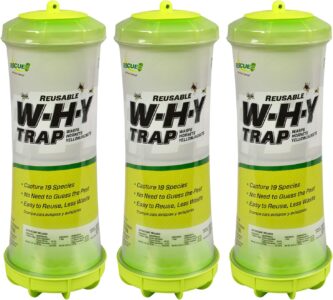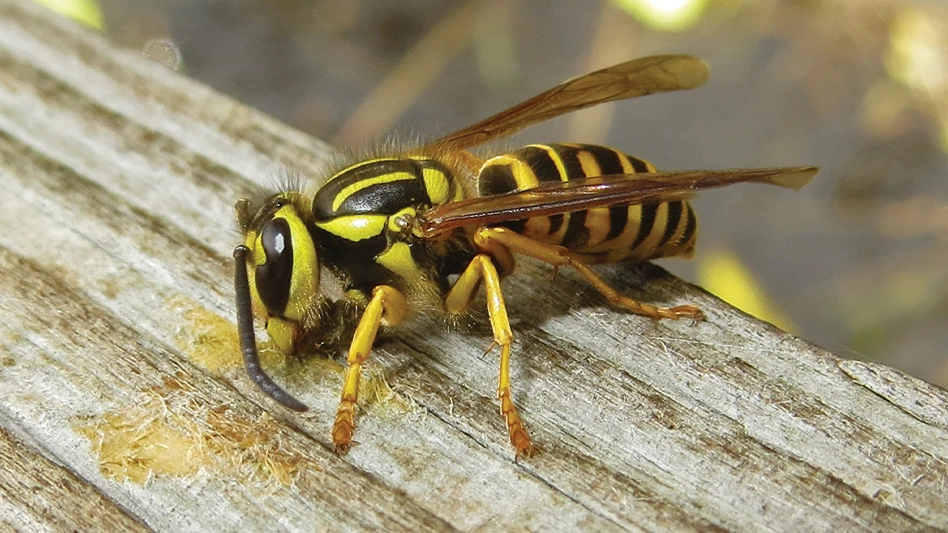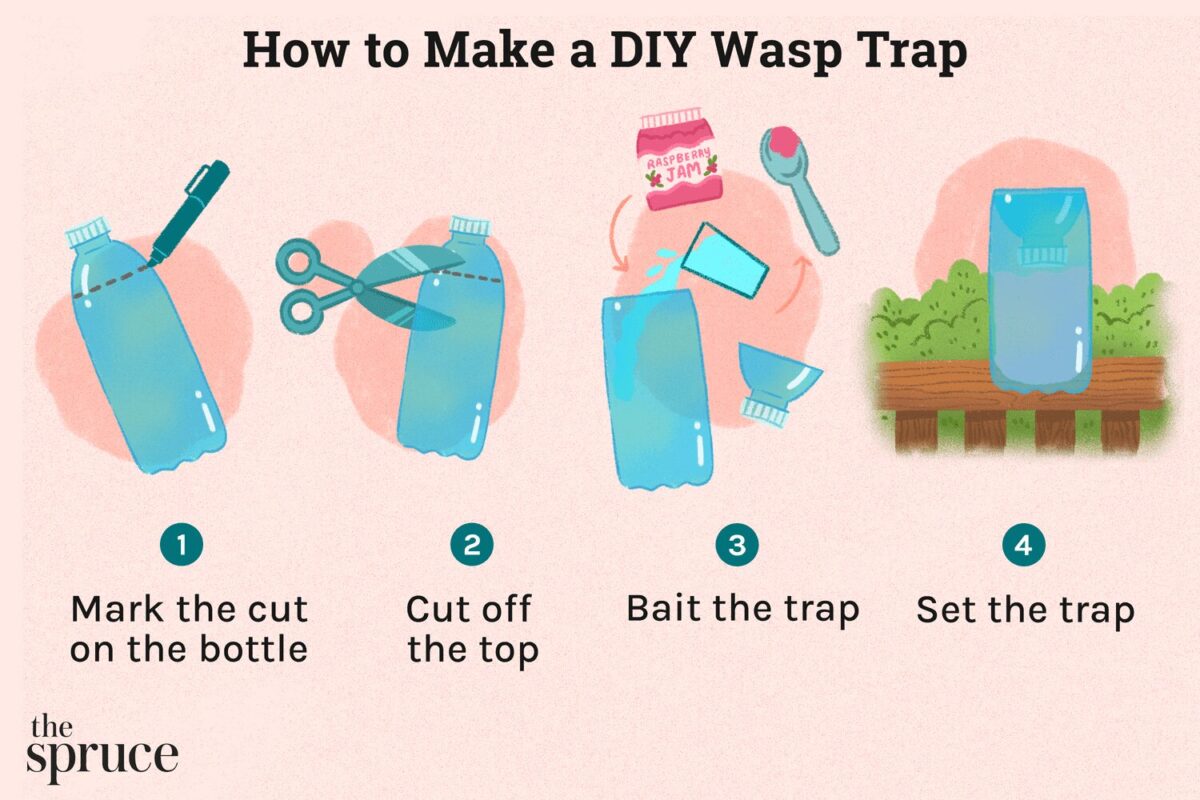Yellow jackets become increasingly aggressive during late summer, making outdoor activities uncomfortable and potentially dangerous. Professional yellow jacket traps offer the most effective solution for reducing these stinging insects around your property, using proven attractants and strategic placement to safely capture workers and queens while protecting beneficial pollinators like honeybees.
Quick Picks: Best Yellow Jacket Traps

Editor’s Choice

Best Multi-Species

Most Effective
- Understanding Yellow Jackets: Why Trapping Works
- 5 Types of Yellow Jacket Traps (Proven Options)
- Strategic Trap Placement: Maximizing Effectiveness
- Proven Bait Formulations for Maximum Effectiveness
- Maintenance and Safety Protocols
- Advanced Trapping Strategies
- When to Call Professional Pest Control
- Frequently Asked Questions
- Conclusion: Effective Yellow Jacket Management
Understanding Yellow Jackets: Why Trapping Works

Yellow jackets are social wasps that live in colonies containing thousands of individuals by late summer. Unlike solitary wasps, they exhibit complex foraging behaviors and aggressive territorial defense, making them particularly problematic around human activity areas.
Colony Growth Pattern
Yellow jacket colonies start with a single queen in spring and can reach 15,000 workers by fall, explaining the dramatic increase in activity during late summer.
Seasonal Diet Changes
Spring and early summer: protein-focused (insects, meat). Late summer: sugar-craving (fruits, beverages, garbage).
Defensive Behavior
Yellow jackets can sting multiple times and release alarm pheromones that attract other colony members to attack perceived threats.
5 Types of Yellow Jacket Traps (Proven Options)
1. Reusable Commercial Traps
Professional-grade reusable traps offer the most consistent long-term results. These traps feature engineered entry systems and proven attractant formulations that target yellow jackets specifically while avoiding beneficial insects.
RESCUE Reusable Yellow Jacket Trap
Editor's ChoiceHow Does It Work
How to Use
- Add the included attractant to the trap following package directions
- Hang the trap at least 20 feet from outdoor activity areas
- Position 4-6 feet above ground in partial shade
- Check weekly and empty when full of dead insects
- Clean with warm soapy water and refill with fresh attractant
- Catches approximately 12 species of North American yellow jackets
- Reusable design provides multi-season value
- Does not attract beneficial honeybees
- Clear visibility allows monitoring without opening trap
- Made in USA with quality construction
- Requires regular maintenance and attractant refills
- Initial cost higher than disposable alternatives
2. Multi-Species Traps
These comprehensive traps target yellow jackets, wasps, and hornets using multiple attractant chambers and entry points, making them ideal for properties with diverse stinging insect problems.
RESCUE WHY Trap for Wasps, Hornets & Yellow Jackets
Best Multi-SpeciesHow Does It Work
How to Use
- Fill top chamber with provided liquid attractant mixed with water
- Place solid lure vial in designated holder
- Pour bottom chamber liquid attractant onto cotton pad
- Hang at least 20 feet from activity areas
- Replace attractants every 2 weeks during peak season
- Catches 19 different species of stinging insects
- Dual-chamber design maximizes capture rates
- Non-toxic operation safe around children and pets
- Durable construction lasts multiple seasons
- More complex setup than single-species traps
- Requires multiple attractant refills
- Higher ongoing costs for replacement lures
3. Disposable Bag Traps
Convenient single-use traps perfect for immediate problems or temporary outdoor events. These traps activate with water and provide effective short-term yellow jacket control.
Pro Tip: Disposable Trap Enhancement
While convenient, disposable traps can be made more effective by adding a small piece of protein (like canned chicken or hot dog) to supplement the included attractant, especially during spring and early summer when yellow jackets seek protein sources.
4. High-Performance Specialty Traps
BioCare Yellow Jacket and Wasp Trap
Most EffectiveHow Does It Work
How to Use
- Fill jar halfway with sugar water, apple juice, or non-citrus juice
- Add 2 drops of dish soap and contents of bait packet
- Add small piece of protein bait for enhanced effectiveness
- Hang securely away from food areas using twist-tie hanger
- Rinse and re-bait every 2-3 weeks or when full
- Proven 9x more effective in university testing
- Uses natural UV attractants yellow jackets prefer
- Non-toxic and environmentally safe
- Reusable design with simple maintenance
- Works best with 4-6 traps per yard
- Requires specific bait preparation
- Performance may vary by geographic region
- More expensive than basic trap designs
5. DIY Bottle Traps
Homemade traps provide an economical option for immediate yellow jacket problems, though they typically require more maintenance and may be less effective than commercial alternatives.

Enhanced DIY Trap Instructions
- Container Selection: Use a clear 2-liter plastic bottle with smooth sides. Remove all labels and clean thoroughly with degreasing dish soap.
- Precision Cutting: Cut the bottle approximately 1/3 from the top, creating a funnel when inverted. Sand cut edges smooth to prevent yellow jacket escape.
- Professional-Grade Bait: Combine 1 cup apple cider vinegar, 1/2 cup sugar, 1 banana peel, and 2 drops liquid dish soap. This mixture mimics fermented fruit that attracts yellow jackets.
- Assembly Technique: Invert the top portion into the bottom, ensuring the neck opening sits 2-3 inches above the bait liquid level.
- Strategic Deployment: Secure the trap with wire or strong string, positioning it 4-6 feet above ground in partial shade.
Strategic Trap Placement: Maximizing Effectiveness
| Placement Factor | Optimal Distance/Position | Reason |
|---|---|---|
| Distance from Activity Areas | Minimum 20 feet from patios, decks, play areas | Draws yellow jackets away from human activity while maintaining effectiveness |
| Height Above Ground | 4-6 feet (tree branches or posts) | Mimics natural foraging patterns and improves visibility to flying insects |
| Sun Exposure | Partial shade to dappled sunlight | Prevents bait from overheating while maintaining attractant volatility |
| Distance from Known Nests | 20+ feet minimum | Intercepts foraging workers without triggering defensive behavior |
| Property Coverage | 4-6 traps per acre for best results | Creates overlapping coverage zones for maximum population reduction |
Seasonal Timing Strategy
Early Spring (March-May)
Target emerging queens with protein-based baits. Catching one queen prevents an entire colony from developing.
Summer (June-August)
Focus on worker population control using balanced protein and sugar baits as colonies rapidly expand.
Late Summer/Fall (September-October)
Peak trapping season using sweet baits as yellow jackets become most aggressive seeking sugar sources.
Proven Bait Formulations for Maximum Effectiveness
Spring Queen-Targeting Baits
- Protein-Rich Mix: Canned white chicken meat + apple juice + 2 drops dish soap
- Commercial Queen Attractant: RESCUE Queen Trap Attractant (specifically formulated for spring trapping)
- Enhanced DIY: Raw hamburger + beer + honey (monitor for other insects)
Summer Worker Control Baits
- Balanced Formula: 50% apple juice, 25% protein source, 25% water + soap
- High-Performance Mix: Dark corn syrup (Karo) + water + small meat portion
- Commercial Standard: RESCUE Yellowjacket Attractant cartridges
Fall Sugar-Seeking Baits
- Fermented Fruit: Overripe banana + apple cider vinegar + sugar water
- Beverage-Based: Flat soda (non-diet) + wine + dish soap
- Premium Mix: Watermelon syrup + apple juice (proven highly effective in testing)
Maintenance and Safety Protocols
Weekly Maintenance Schedule
- Inspection Protocol: Check traps every 3-4 days during peak season. Look for capture rates, bait level, and trap condition.
- Safe Emptying Procedure: Empty traps at dusk or dawn when yellow jackets are least active. Wear protective clothing and ensure all insects are dead before handling.
- Cleaning Method: Rinse traps with hot soapy water to remove pheromones and residue that could reduce effectiveness.
- Bait Refresh: Replace attractants every 1-2 weeks or when capture rates decline, as degraded bait loses potency.
- Position Adjustment: Monitor effectiveness and relocate underperforming traps to areas with higher yellow jacket activity.
Trap Performance Optimization
Performance Indicators
- Excellent: 50+ yellow jackets per week indicates optimal placement and bait selection
- Good: 20-50 captures suggests effective but potentially improvable setup
- Poor: Under 10 captures requires bait change or trap relocation
- Problem: Honeybees in trap indicates wrong bait formula – switch to yellow jacket-specific attractants
Advanced Trapping Strategies
Multi-Zone Coverage System
Professional pest managers use systematic trap placement to create overlapping coverage zones. This approach intercepts yellow jackets at multiple points along their foraging routes, significantly reducing populations reaching target areas.
| Property Size | Recommended Traps | Placement Strategy | Expected Results |
|---|---|---|---|
| Small Yard (1/4 acre) | 2-3 traps | Perimeter placement focusing on entry points | 60-80% population reduction |
| Medium Property (1/2 acre) | 4-6 traps | Strategic grid with emphasis on problem areas | 70-85% population reduction |
| Large Property (1+ acre) | 8-12 traps | Comprehensive coverage with specialized bait zones | 80-90% population reduction |
Professional Integration Techniques
- Bait Rotation: Alternate between protein and sugar baits every 2 weeks to match seasonal preferences
- Pheromone Monitoring: Use yellow jacket alarm pheromone indicators to identify high-activity areas
- Weather Adaptation: Adjust trap height and protection based on seasonal weather patterns
- Population Assessment: Track capture rates to determine when professional intervention may be needed
When to Call Professional Pest Control
Signs Professional Help is Needed
- Multiple Active Nests: More than 2-3 visible nests on your property indicates a significant infestation
- Indoor Infiltration: Yellow jackets entering structures suggest wall or attic nests requiring specialized removal
- Trap Ineffectiveness: Consistently low capture rates despite proper placement and bait may indicate overwhelming population levels
- Aggressive Behavior: Unprovoked attacks or territorial guarding behavior around specific areas
- Structural Damage: Evidence of nest-building in walls, eaves, or underground near foundations
Integrated Pest Management Approach
The most effective yellow jacket control combines trapping with other preventive measures. Professional pest managers recommend a comprehensive approach that addresses both immediate populations and long-term prevention.
Prevention
Seal garbage containers, clean up food debris, and eliminate water sources that attract foraging yellow jackets.
Targeted Trapping
Use species-specific traps with scientifically-proven attractants for maximum effectiveness.
Professional Treatment
Nest removal and targeted applications for severe infestations or dangerous nest locations.
Frequently Asked Questions
How many yellow jacket traps do I need for my yard?
For optimal results, use 4-6 traps per acre of property. Smaller yards (1/4 acre or less) typically need 2-3 strategically placed traps, while larger properties may require 8-12 traps for comprehensive coverage.
Place traps at least 20 feet from outdoor activity areas and focus on property perimeters where yellow jackets typically enter from neighboring areas.
What’s the best time of year to start using yellow jacket traps?
Begin trapping in early spring (March-April) to catch emerging queens before they establish colonies. One trapped queen prevents an entire colony of thousands of workers from developing.
Continue trapping through fall, adjusting bait types seasonally: protein-based baits in spring, balanced formulations in summer, and sweet baits in late summer/fall.
Do yellow jacket traps attract beneficial insects like honeybees?
Quality commercial yellow jacket traps are specifically designed to avoid attracting honeybees. They use attractant formulations that target yellow jacket preferences while being less appealing to beneficial pollinators.
DIY traps with overly sweet baits may attract honeybees, so monitor your traps and adjust bait formulations if you notice beneficial insects being captured.
How often should I empty and refill yellow jacket traps?
Check traps every 3-4 days during peak season (August-October) and empty when they’re about 75% full. Overfilled traps can allow yellow jackets to escape by climbing over dead insects.
Replace attractants every 1-2 weeks or when capture rates decline, as degraded bait loses effectiveness. Clean traps with hot soapy water to remove pheromones that might reduce future captures.
Can yellow jacket traps eliminate an entire nest?
Traps effectively reduce worker populations and can significantly impact smaller colonies, but they typically won’t eliminate large, established nests. A mature yellow jacket colony can contain 15,000+ individuals.
For complete nest elimination, especially ground nests or structural infestations, professional pest control treatment is usually necessary along with trapping for population management.
Is it safe to use yellow jacket traps around children and pets?
Commercial yellow jacket traps are generally safe around children and pets when properly positioned. Place traps at least 20 feet from play areas and 4-6 feet above ground to prevent accidental contact.
Most commercial traps use non-toxic attractants, but always supervise children around any pest control devices and follow manufacturer safety guidelines.
Conclusion: Effective Yellow Jacket Management
Yellow jacket traps represent a crucial component of effective stinging insect management, offering both immediate population reduction and long-term control when used strategically. The key to success lies in selecting appropriate trap types for your specific situation, using proven attractant formulations, and maintaining consistent placement and maintenance protocols.
For maximum effectiveness, implement a comprehensive approach that combines early-season queen trapping, strategic multi-zone placement, and seasonal bait rotation. Remember that trapping works best as part of an integrated pest management strategy that includes prevention measures and professional intervention when necessary.
By following the evidence-based strategies outlined in this guide, you can significantly reduce yellow jacket populations around your property, creating safer outdoor spaces for family activities and entertaining. Monitor trap performance regularly, adjust placement and baits based on results, and don’t hesitate to seek professional assistance for severe infestations or dangerous nest locations.
Season-End Protocol
Continue trapping through the first hard frost, as yellow jacket activity can persist well into fall. Late-season trapping helps reduce overwintering queen populations, leading to fewer colonies the following spring.



